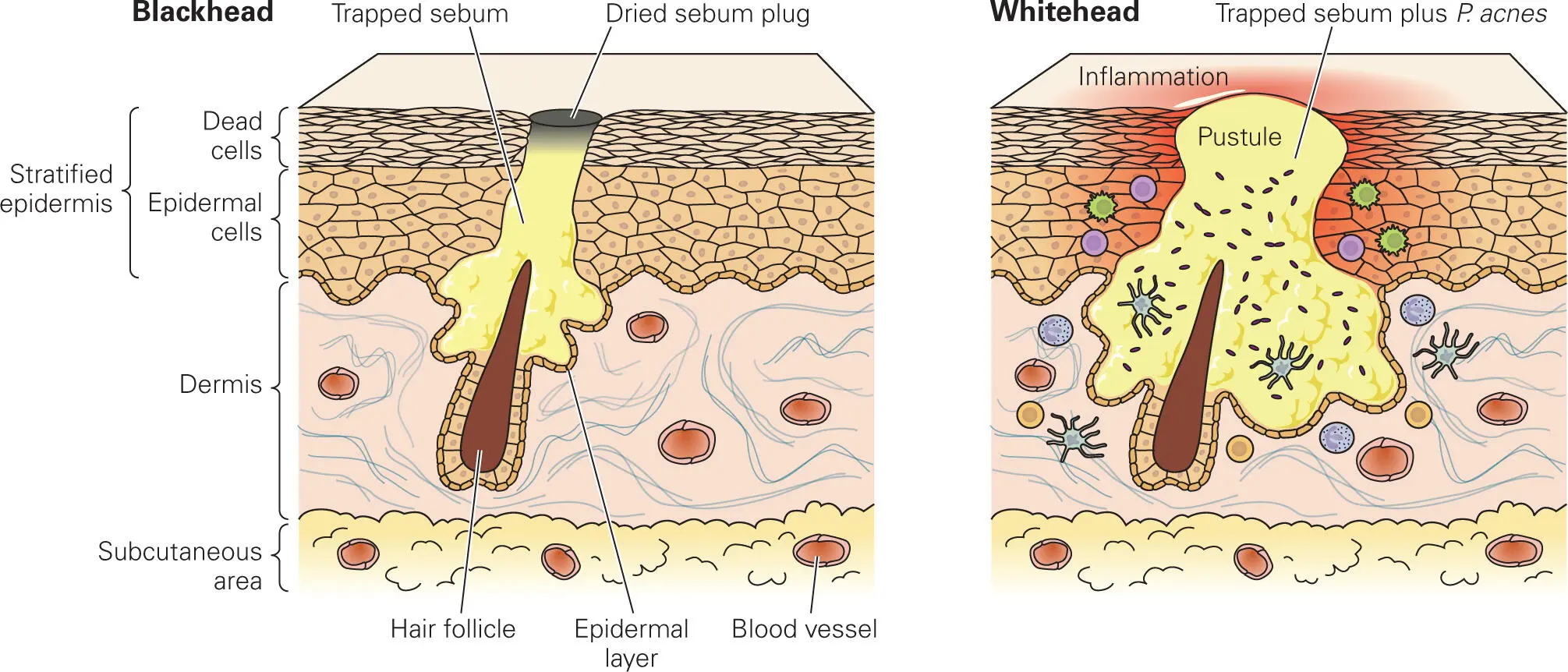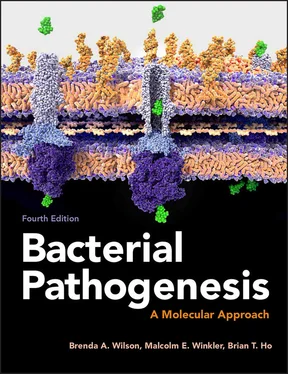The defenses of the skin do not completely prevent bacterial growth, as is evident from the fact that there are some bacteria capable of colonizing skin and mucosal surfaces. Immediately after birth, a wide range of microbes colonize humans, particularly on the skin and in the oronasopharyngeal, gastrointestinal, and urogenital tracts. The members of a bacterial population that are found residing at a particular body site without causing disease are called the resident (or commensal) microbiota of that site.
The skin microbiota, consisting primarily of the Gram-positive bacteria Staphylococcus epidermidis and Propionibacterium acnes, help protect against pathogenic bacteria by occupying sites that might be colonized by pathogenic bacteria. They also compete with incoming pathogens for essential nutrients. Some resident bacteria also produce antagonistic bactericidal compounds (e.g., pore-forming toxins such as bacteriocins or growth inhibitors, which target other bacteria). The commensal microbiota does not completely prevent colonization of skin by potential pathogens, but hampers it enough that colonization by pathogenic bacteria is usually transient.
In the case of P. acnes, this anaerobic bacterium colonizes sebaceous (fat) glands and digests the oily sebum, composed of triglycerides, waxy esters, squalene, and free fatty acids, to help generate a low pH environment that is protective against other bacteria. Sebum production and secretion by sebaceous glands is increased by testosterone. During puberty, testosterone levels increase, particularly in males, and cause overgrowth of P. acnes in response to the abundance of sebum production. Air-oxidized sebum plugs the hair follicle or gland duct and gives rise to a clogged follicle (called a comedo) that is open (also known as a blackhead) ( Figure 2-4). Dried sebum causes dead skin cells to adhere at the opening of the fat gland, which gives rise to a comedo that is closed and accumulates sebum (also known as a whitehead). The resulting anaerobic environment further enhances bacterial growth, causing infection and inflammation that manifests as acne (i.e., pimples or zits), or in severe cases as cysts or boils. Treatment with antibiotics and benzoyl peroxides found in most acne medications work against P. acnes. Washing with warm water and soap can also help reduce acne by keeping the pores open and free of dried sebum.

Figure 2-4. Skin infection with the commensal bacteria. Overgrowth of the commensal bacterium Propionibacterium acnes can lead to formation of a comedo that is open but plugged with air-oxidized sebum (blackhead) or closed by sebum-glued skin cells (whitehead). Inflammation of the comedo leads to acne (pimples).
Although most mucosal surfaces are protected by normal resident microbiota (exceptions being the uterus and upper female genital tract and the urinary tract), the species composition of the microbiota found at different parts of the body varies from one site to another. Nonetheless, all have in common the predominance of Gram-positive resident bacteria. Shifts in these populations can be pathological, as is seen from diseases such as periodontal disease and bacterial vaginosis. The large intestine (colon) harbors an abundant and rich assortment of normal microbiota, the majority (97%) of which are anaerobes or facultative anaerobes. Many of these bacteria use carbohydrates and fats that are not digested by the stomach or absorbed by the small intestine. In return, some resident microbes provide a beneficial function to the host by synthesizing and secreting vitamins (e.g., vitamin K, vitamin B12, and other B vitamins) and other nutrients that the intestine can absorb. Recent experimental evidence indicates that indigenous bacteria play a crucial inducive role in gut and immune development during early postnatal life. They stimulate development of certain tissues, in particular the caecum and Peyer’s patches, the latter of which stimulate production of cross-reactive antibodies that prevent infection by related bacteria that may be pathogens (more on this later).
Members of the skin microbiota normally do not cause human infections unless they are introduced into the body by abrasions, catheters, or surgery. Staphylococcus epidermidis, a common skin bacterium, has been implicated in postsurgical and catheter-related infections. (S. epidermidis was the bacterial villain in the surgeon-transmitted infections described in Box 2-1.) Relatively nonpathogenic bacteria like S. epidermidis would normally be rapidly killed by the defenses of the bloodstream, but if they can reach an area that is somewhat protected from host defenses, such as the plastic surface of a heart valve implant, they can grow into surface-attached biofilms and produce quite serious infections. Catheters can provide skin-associated bacteria with a conduit into the bloodstream, thus bypassing the defenses of the epidermis and dermis. Catheter-associated infections have become a serious enough problem in hospitals that catheter companies are developing plastic catheters that are impregnated with antibacterial compounds.
Box 2-1.
Notable Breaches in Host Defenses that Changed the Course of U.S. History
Four presidents of the United States were assassinated during their presidencies: Abraham Lincoln (16th president: 1861–1865), James A. Garfield (20th president: 1881), William McKinley, Jr. (25th president: 1897–1901), and John F. Kennedy (35th president: 1961–1963). Kennedy died shortly after being shot, Lincoln died about nine hours afterward, and McKinley survived for about a week before dying, whereas Garfield lasted for 11 weeks before succumbing. Lincoln and Kennedy clearly died from complications due to the damage from the bullets’ impact. In contrast, Garfield and McKinley did not die from the impact of the bullets that hit them, but instead they succumbed to the subsequent infections resulting from the wounds. In both cases, the lethal infections were caused by bacteria introduced by the physicians trying to remove the bullets lodged in their bodies.
In Garfield’s case, one bullet grazed his shoulder and another hit his back, barely missing his spine before lodging in his pancreas, where doctors could not find it. Garfield was shot on July 2, 1881, and although his condition fluctuated with apparent signs of recovery alternating with fevers from infection, his illness worsened over the summer. Blood poisoning (sepsis) eventually took hold, and pus-filled abscesses formed all over his body. He finally died from uncontrolled septicemia (bacteria in bloodstream) and a ruptured splenic aneurysm on September 19, 1881. Most historians and medical experts are convinced that Garfield might have lived had the physicians of his time believed in aseptic technique while probing for the bullet, instead of using unwashed fingers and instruments.
Twenty years later, on September 14, 1901, McKinley died from gangrene resulting from bullet wounds received on September 6. Again, one bullet grazed McKinley while the other entered his abdomen and could not be found. Initially, he seemed to be on the mend, but his condition deteriorated rapidly on September 13 and he died early the next day. Although medical practices and precautions against infections were much improved by 1901, autopsy revealed that the bullet had penetrated the stomach, colon, kidney, and peritoneum along its way. These breaches to the normal epithelial barriers introduced the contents from the stomach and colon into the body’s tissues and the bloodstream, leading to the subsequent sepsis and death.
Sources:
Leech M. 1959. In the Days of McKinley. Harper and Brothers, New York, NY.
Читать дальше













